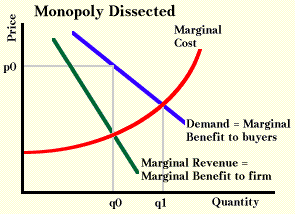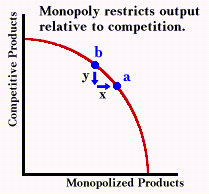What is Wrong with Monopoly?
Economists have rather consistently argued that monopoly is undesirable. On this issue they are probably not in disagreement with the public's rhetoric, though they sometimes see monopoly problems in different places than the public does.
A monopoly is an industry in which there is one seller. Because it is the only seller, the monopolist faces a downward-sloping demand curve, the industry demand curve. The downward-sloping demand curve means that if the monopolist wants to sell more, it must lower its price. (We are assuming that price discrimination is not possible; that the firm can charge only one price.) Because the monopolist must lower price to sell more, the extra or marginal revenue it gets from selling another unit is less than the price it charges. Thus, its marginal revenue curve lies below its demand curve. In contrast, for a seller who is a price taker, demand is identical with marginal revenue.
The table below illustrates the case of monopoly. Marginal cost is the value of the additional resources needed to produce another unit of output. The marginal benefit to consumers is the price that consumers are willing to pay for each unit. You should recognize this column as a demand curve. The maximization principle tells us that the economically efficient amount to produce is five, the amount that gives consumers the greatest value. To produce the first unit, the firm takes resources that have a value of $5.00 and turns them into something with a value of $7.01. Because this transformation has increased value, producing the first unit is more economically efficient than producing none. By this logic, producing the sixth unit would decrease economic efficiency because the firm would take resources with a value of $5.00 and transform them into something with a value of only $4.51.
|
|
|||
|
|
|
to Buyers |
to Seller |
|
|
|
|
|
|
|
|
|
|
|
|
|
|
|
|
|
|
|
|
|
|
|
|
|
|
|
|
|
|
The monopolist, however, will find it most profitable to produce only three units because it does not see marginal benefit the same way that buyers see it. For the seller, the extra benefit of the second unit is only $6.01. It sells the second unit for $6.51, but to sell the second unit, it had to reduce the price it charged by $.50. Thus, it "lost" $.50 on the first unit, so the net increase in its revenue was only $6.01. (You can get the same answer by computing a total revenue column and then calculating revenue increases.) In a similar manner, the rest of the fourth column can be obtained.
Using the maximization principle, one can see that producing beyond the third unit is not in the interests of the firm. The fourth unit brings in added benefits of only $4.01 to the firm (it sells for $5.51, but to sell it, the firm lowers price by $.50 on three other units), but costs an added $5.00. From the point of view of the buyers, however, the fourth unit should be produced. It brings them added benefits of $5.51 and uses resources worth only $5.00.
The discussion above is illustrated below. The seller attempts to set marginal cost equal to marginal revenue, or to produce at q0. From the consumers' viewpoint, the best amount to produce would be q1. The monopolist restricts output because of a divergence between marginal benefit as the firm perceives it and marginal benefit as buyers perceive it. Producing beyond q0 is not in the interests of the firm because the extra benefit it sees, the marginal revenue curve, is less than the extra cost of production, shown by the marginal cost curve. Extra output is in the interests of buyers because the extra benefit they get, shown by the demand curve, is greater than the extra costs of production.

In terms of the production-possibilities frontier shown below, an economy with some industries competitive (all transactors are price takers) and others monopolized (sellers are price searchers) will produce at point b. However, consumers would be better off at point a because the gain of x amount of monopolized goods has a greater value than the loss of y amount of competitive goods. Because a monopolist restricts production from what a competitive industry would do, too many resources are being used in the competitive industry and not enough in the monopolized industry. Thus, the existence of monopoly violates product-mix efficiency. Because marginal rates of substitution are not equal to marginal rates of transformation, the economy produces the wrong mix of products.

The unexploited value of monopoly leads to two questions. First, one can ask whether people have found ways to capture this value. Because the search for value occupies a great deal of people's talents and energies in a market economy, it should not surprise us to learn that there is a commonly-used way to capture this value. Sellers can capture it with price discrimination.
Second, one can ask if the government can eliminate the unexploited value with some sort of intervention. Economists have suggested two important ways for the government to intervene, through antitrust actions and through regulation.
However, before we turn to these topics of price discrimination, antitrust, and regulation, we look at situations that may be near-monopolies. In these situations there is more than one seller, but the sellers may act like a monopoly by restricting transactions below the economically efficient level, leaving unexploited value.
Copyright Robert Schenk